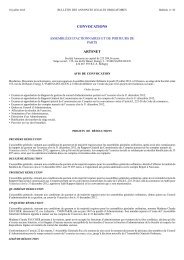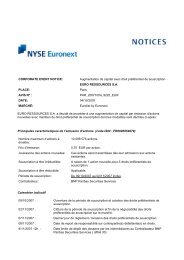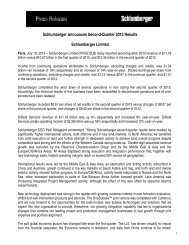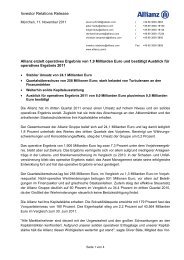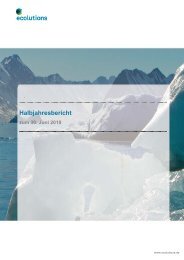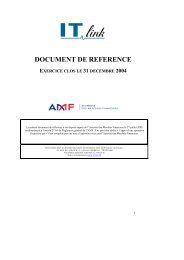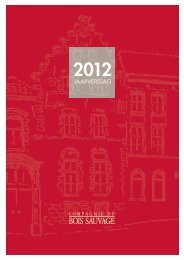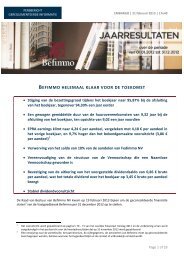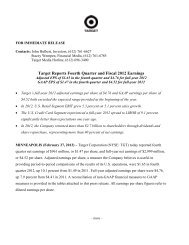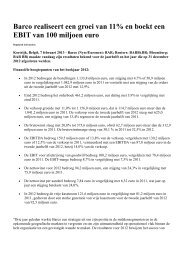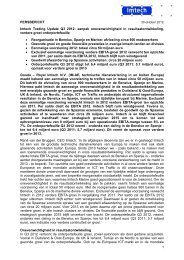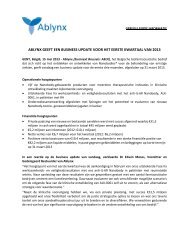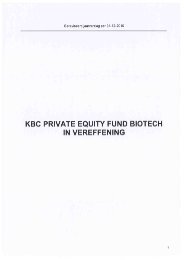Download full Annual Report and Accounts - Kingfisher
Download full Annual Report and Accounts - Kingfisher
Download full Annual Report and Accounts - Kingfisher
Create successful ePaper yourself
Turn your PDF publications into a flip-book with our unique Google optimized e-Paper software.
Kingfi sher plc<br />
<strong>Annual</strong> <strong>Report</strong><br />
<strong>and</strong> <strong>Accounts</strong><br />
2009/10<br />
the Group’s weighted average cost of capital with appropriate adjustments for<br />
the risks associated with the relevant cash generating unit or groups of cash<br />
generating units. When the recoverable amount of the goodwill is less than its<br />
carrying amount, an impairment loss is recognised immediately in the income<br />
statement which cannot subsequently be reversed. Gains <strong>and</strong> losses on the<br />
disposal of an entity include the carrying amount of goodwill relating to the<br />
entity sold.<br />
(ii) Computer software<br />
Acquired computer software licences are capitalised on the basis of the costs<br />
incurred to acquire <strong>and</strong> bring to use the specifi c software. These costs are<br />
amortised over their estimated useful lives of two to fi ve years.<br />
Costs that are directly associated with the production of identifi able <strong>and</strong> unique<br />
software products controlled by the Group, which are expected to generate<br />
economic benefi ts exceeding costs beyond one year, are recognised as<br />
intangible assets. Direct costs include software development, employee<br />
<strong>and</strong> consultancy costs <strong>and</strong> an appropriate portion of relevant overheads.<br />
Costs associated with identifying, sourcing, evaluating or maintaining<br />
computer software are recognised as an expense as incurred.<br />
h. Property, plant <strong>and</strong> equipment<br />
(i) Cost<br />
Property, plant <strong>and</strong> equipment held for use in the business are carried at cost<br />
less accumulated depreciation <strong>and</strong> any provisions for impairment.<br />
(ii) Depreciation<br />
Depreciation is provided to refl ect a straight line reduction from cost to<br />
estimated residual value over the estimated useful life of the asset as follows:<br />
Freehold l<strong>and</strong> – not depreciated<br />
Freehold <strong>and</strong> long leasehold buildings – over remaining useful life<br />
down to residual value<br />
Short leasehold l<strong>and</strong> <strong>and</strong> buildings – over remaining period of the lease<br />
Fixtures <strong>and</strong> fi ttings – between 4 <strong>and</strong> 20 years<br />
Computers <strong>and</strong> electronic equipment – between 2 <strong>and</strong> 5 years<br />
Motor cars – 4 years<br />
Commercial vehicles – between 3 <strong>and</strong> 10 years<br />
Long leaseholds are defi ned as those having remaining lease terms of more<br />
than 50 years. Asset lives <strong>and</strong> residual values are reviewed at each balance<br />
sheet date.<br />
(iii) Impairment<br />
Property, plant <strong>and</strong> equipment are reviewed for impairment if events or<br />
changes in circumstances indicate that the carrying amount may not be<br />
recoverable. When a review for impairment is conducted, the recoverable<br />
amount is assessed by reference to the net present value of expected future<br />
pre-tax cash fl ows (‘value-in-use’) of the relevant cash generating unit or fair<br />
value less costs to sell if higher. The discount rate applied is based upon the<br />
Group’s weighted average cost of capital with appropriate adjustments for<br />
the risks associated with the relevant cash generating unit. Any impairment<br />
in value is charged to the income statement in the period in which it occurs.<br />
(iv) Disposal<br />
The gain or loss arising on the disposal or retirement of an asset is determined<br />
as the difference between the sales proceeds <strong>and</strong> the carrying amount of the<br />
asset <strong>and</strong> is recognised in the income statement. Sales of l<strong>and</strong> <strong>and</strong> buildings<br />
are accounted for when there is an unconditional exchange of contracts.<br />
(v) Subsequent costs<br />
Subsequent costs are included in the related asset’s carrying amount or<br />
recognised as a separate asset, as appropriate, only when it is probable<br />
that future economic benefi ts associated with the item will fl ow to the Group<br />
<strong>and</strong> the cost of the item can be measured reliably. All other repairs <strong>and</strong><br />
maintenance are charged to the income statement in the period in which<br />
they are incurred.<br />
63<br />
i. Leased assets<br />
Where assets are fi nanced by leasing agreements which give rights approximating<br />
to ownership, the assets are treated as if they had been purchased outright.<br />
The amount capitalised is the lower of the fair value or the present value of the<br />
minimum lease payments during the lease term at the inception of the lease.<br />
The assets are depreciated over the shorter of the lease term or their useful life.<br />
Obligations relating to fi nance leases, net of fi nance charges in respect of<br />
future periods, are included, as appropriate, under borrowings due within or<br />
after one year. The fi nance charge element of rentals is charged to fi nance<br />
costs in the income statement over the lease term.<br />
All other leases are operating leases <strong>and</strong> the rental payments are generally<br />
charged to the income statement in the period to which the payments relate,<br />
except for those leases which incorporate fi xed minimum rental uplift clauses.<br />
Leases which contain fi xed minimum rental uplifts are charged to the income<br />
statement on a straight line basis over the lease term.<br />
Where a lease is taken out for l<strong>and</strong> <strong>and</strong> buildings combined, the buildings<br />
element of the lease may be capitalised as a fi nance lease if it meets the<br />
criteria for a fi nance lease, but the l<strong>and</strong> element will in most cases be classifi ed<br />
as an operating lease. If the contracted lease payments are not split between<br />
l<strong>and</strong> <strong>and</strong> buildings in the lease contract, the split is made based on the market<br />
values of the l<strong>and</strong> <strong>and</strong> buildings at the inception of the lease.<br />
Incentives received or paid to enter into lease agreements are released to the<br />
income statement on a straight line basis over the lease term.<br />
j. Investment property<br />
Investment property is property held by the Group to earn rental income or for<br />
capital appreciation. The Group’s investment properties are carried at cost less<br />
depreciation <strong>and</strong> provision for impairment.<br />
k. Capitalisation of borrowing costs<br />
Interest on borrowings to fi nance the construction of properties held as<br />
non-current assets is capitalised from the date work starts on the property<br />
to the date when substantially all the activities which are necessary to get<br />
the property ready for use are complete. Where construction is completed in<br />
parts, each part is considered separately when capitalising interest. Interest<br />
is capitalised before any allowance for tax relief.<br />
l. Inventories<br />
Inventories are carried at the lower of cost <strong>and</strong> net realisable value, on a<br />
weighted average cost basis.<br />
Cost includes appropriate attributable overheads <strong>and</strong> direct expenditure<br />
incurred in the normal course of business in bringing goods to their present<br />
location <strong>and</strong> condition. Costs of inventories include the transfer from equity<br />
of any gains or losses on qualifying cash fl ow hedges relating to purchases.<br />
Net realisable value represents the estimated selling price in the ordinary<br />
course of the business less the estimated costs necessary to make the sale.<br />
Write downs to net realisable value are made for slow moving, damaged or<br />
obsolete items <strong>and</strong> other events or conditions resulting in expected selling<br />
prices being lower than cost. The carrying value of inventories refl ects known<br />
<strong>and</strong> expected losses of product in the ordinary course of business.<br />
m. Employee benefi ts<br />
(i) Post employment benefi ts<br />
The Group operates various defi ned benefi t <strong>and</strong> defi ned contribution pension<br />
schemes for its employees, some of which are required by local legislation.<br />
A defi ned benefi t scheme is a pension scheme which defi nes an amount<br />
of pension benefi t which an employee will receive on retirement. A defi ned<br />
contribution scheme is a pension scheme under which the Group usually pays<br />
fi xed contributions into a separate entity. In all cases other than some of the<br />
legally required schemes, a separate fund is being accumulated to meet the<br />
accruing liabilities. The assets of each of these funds are either held under<br />
trusts or managed by insurance companies <strong>and</strong> are entirely separate from<br />
the Group’s assets.



